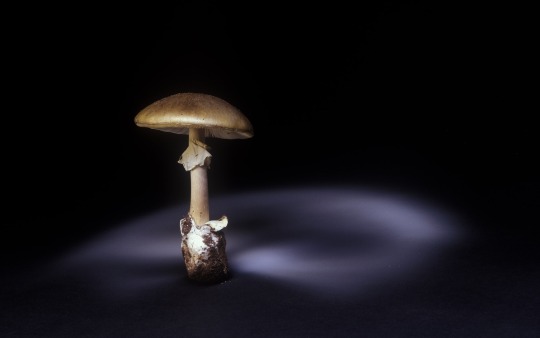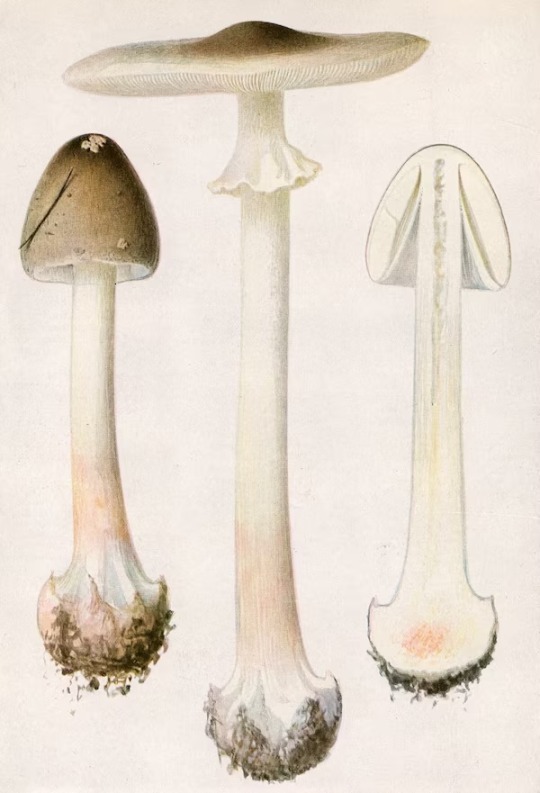#Fungus | Wiped Out | American Chestnut 🌰 Trees 🌲
Explore tagged Tumblr posts
Text
Environment: Death Cap Mushrooms are Extremely Deadly—and They’re Spreading
The Invasive Death Cap Mushroom is thriving in North America. While it can be difficult to distinguish from an edible one, make no mistake: It can do a number on you.
— By Emily Martin | August 31, 2023

The Death Cap is the World's Deadliest Fungus, responsible for 90 percent of the World's Mushroom-related Poisonings every year. Native to Europe, Death Caps have spread around the World over the past Century. Photograph By Yves Lanceau/Nature Picture Library
The name itself is both alarming and self-explanatory: the death cap mushroom.
Scientifically known as Amanita phalloides, death caps are responsible for 90 percent of the mushroom-related fatalities that occur every year, making them the world’s most lethal mushroom. The infamous fungus was recently in the news after three people in Australia died after ingesting what investigators suspect were death caps.
The mushroom originates from the U.K. and parts of Ireland, but over the past century, it has hijacked trips around the world, spreading to Australia and North America.
Since arriving on the West Coast, the invasive mushroom has spread rapidly throughout California and has even appeared as far north as British Columbia, but much about its arrival remains a mystery. Why the mushroom spread so quickly, when exactly it arrived, and how it will impact the environment it grows in are the topics of ongoing research.
Here’s what you need to know about this deadly mushroom—and how to spot one—in case it emerges in a forest near you.
How The Mushroom Earned Its Name
The unassuming mushroom can grow up to six inches tall with a similarly sized domed cap, sometimes tinged yellow or green. Under its cap are white gills and an off-white stem—characteristics that make it difficult to distinguish from an edible mushroom.
Yet unlike an edible mushroom, it can cause extreme damage to the liver and kidneys, or in some cases, death.
That’s because the mushrooms contain a unique set of toxins, says U.S. Department of Agriculture plant pathologist Milton Drott. Though it is safe to the touch, a death cap contains amatoxins, which prevent cells from creating proteins, ultimately causing cell death and organ failure.
Drott notes that these toxins may have allowed the populations spreading through the U.S. to thrive, serving up a defense against any new predators the fungus encounters in its environment.
But studying the death cap mushroom can be difficult. It’s challenging to replicate ideal environmental conditions for a mushroom in a lab, and studying plucked mushrooms requires complex DNA sequencing.
Some fungi can damage the environment, like the fungus that wiped out American Chestnut trees, but so far, there’s no strong evidence that death caps are a threat to their new environments. In fact, trees and other plants benefit from their presence.
Death caps are a mycorrhizal fungi, which means they form a relationship with plants that’s mutually beneficial for both plant and fungus. The plant receives nutrients from the soil that the fungus extracts, while the fungus receives sugars from the plant.
A Mysterious Move Around The World
It’s nearly impossible to pinpoint the actual moment the deadly mushroom made its way to the western U.S. and why exactly it’s continued to spread since then, says Anne Pringle, a mycologist at the University of Wisconsin-Madison and a leading expert on death caps.
The earliest record of the mushroom in California is from the 1930s. Some researchers theorize that death caps immigrated in the soil of a cork tree transported from Europe to California to make corks for a then burgeoning wine industry. Others say the mushroom may have hitched a ride on a mystery plant imported to beautify college campuses.
Regardless, both Pringle and Drott say the only thing they’re certain of is that the fungus was likely dormant—and thus hidden from human eyes—in an imported plant’s soil.

Scientifically known as Amanita Phalliodes—Death Caps were first spotted in California in the 1930s. Some scientists think they were imported in the soil of cork trees, used to make corks for California's wine makers.
“When they planted that tree in the ground, they also effectively planted the fungus. So, what exactly is the smoking gun, who did it, and when—that's the thing I think we'll never truly know,” Pringle says.
Pringle can’t say for sure what makes the state such a friendly habitat for the invasive species, but she does note that the fungus can tolerate different environments throughout Europe, growing as far north as Sweden and as far south as southern France.
Since arriving, Pringle says its geographic extent has grown larger and spread to other States; most recently it appeared in Idaho.
Retracing Their Steps
When scientists first spotted death caps in the U.S., they thought they may be native to the region because of how widespread they are.
In 2009, Pringle was the first to label the population in California as invasive, a discovery she made by inspecting the mushrooms’ DNA.
“When they planted that tree in the ground, they also effectively planted the fungus. So what exactly is the smoking gun, who did it and when, that's the thing I think we'll never truly know.”
— Anne Pringle
And when scientists did realize the death cap had newly spread into the U.S., there wasn’t any preexisting data to provide clues about where exactly it entered North America and how quickly it multiplied.
“There's so many ideas to test, it’s hard to even know where to get started,” Pringle says.
Research on invasive fungi in the environment is quite new, Pringle says, so answers to questions of why death caps are spreading and its impact on local ecosystems may still be years away.
Drott thinks the mushroom may be proliferating because it thrives in its new soil and with its adoptive plants, or there may be a lack of predators in these new habitats to keep death cap populations in check.
His research has revealed at least one clue: the genes responsible for producing toxins in American death caps are extremely unique, distinct from their genetic cousins in Europe, and may be the key to understanding how the invasive plant has thrived in North America.
Earlier this year, scientists published preliminary research suggesting the death cap can reproduce both with and without a mate, and that a single fungus can live a long, reproductive life.
Encountering A Death Cap
Spotting a death cap requires vigilance.
“It’s scary that these [pass for] delicious mushrooms,” Drott says.
He adds that, in addition to an unalarming physical appearance, the death caps’ toxins don’t smell or provide any other obvious giveaways. Its toxins are also extremely stable when heated and don’t break down when cooked, unlike other edible fungi that are only dangerous to eat raw.
That’s why scientists suggest erring on the side of caution and steering clear of foraging mushrooms. Pringle also emphasizes the importance of learning the plants in your local environment.
“If you can tell the difference between Swiss chard and spinach, you can learn difference between edible and poisonous mushrooms,” Pringle says, emphasizing the small but recognizable differences between the two greens. “People want a magic rule, but there’s nothing I can hand you in a sentence or paragraph."
Rather, she says identifying physical differences between death caps and a safe mushroom can become easier with exposure.
Spreading Awareness
Many death caps have been found in National Parks, including Point Reyes National Seashore in California, where Pringle assisted with a study on the invasion in 2010.
National Park Service (NPS) science advisor Ben Becker notes that parks are constantly seeing new invasive species with the frequent movement of people and equipment, and the death cap is a good example of how humans can transport tiny fungal invaders around the world.
Becker says NPS works with local mushroom science groups like the Bay Area Mycological Society to spread public awareness about the dangers of foraging mushrooms.
If you’re concerned about something you have eaten, go to the emergency room and if possible, take pieces of the mushroom you ate for identification.
And as many foragers and scientists say, don’t munch on a hunch.
#Environment#Mashroom | Amanita Phalliodes—Death Caps#Spotted | California | 1930s#Imported | Soil | Cork Trees 🌲#Extremely Deadly#Invasive#North America 🇺🇸#Difficult | Distinguish#Emily Martin | National Geographic#Native | Europe 🇪🇺#Deaths | Australia 🇦🇺#UK 🇬🇧 | Ireland 🇮🇪#West Coast | California | US 🇺🇸#British Columbia#U.S. Department of Agriculture | Plant 🌱 Pathologist | Milton Drott#Toxins#Thrive#Complex DNA Sequencing#Fungus | Wiped Out | American Chestnut 🌰 Trees 🌲#Anne Pringle | Mycologist | University of Wisconsin-Madison#Sweden 🇸🇪 | France 🇫🇷#Idaho#Vigilance#Swiss Chard | Spinach#Dangerous | Eat Raw#National Parks | Point Reyes National Seashore in California#National Park Service (NPS)#Science Advisor | Ben Becker#Bay Area Mycological Society
0 notes